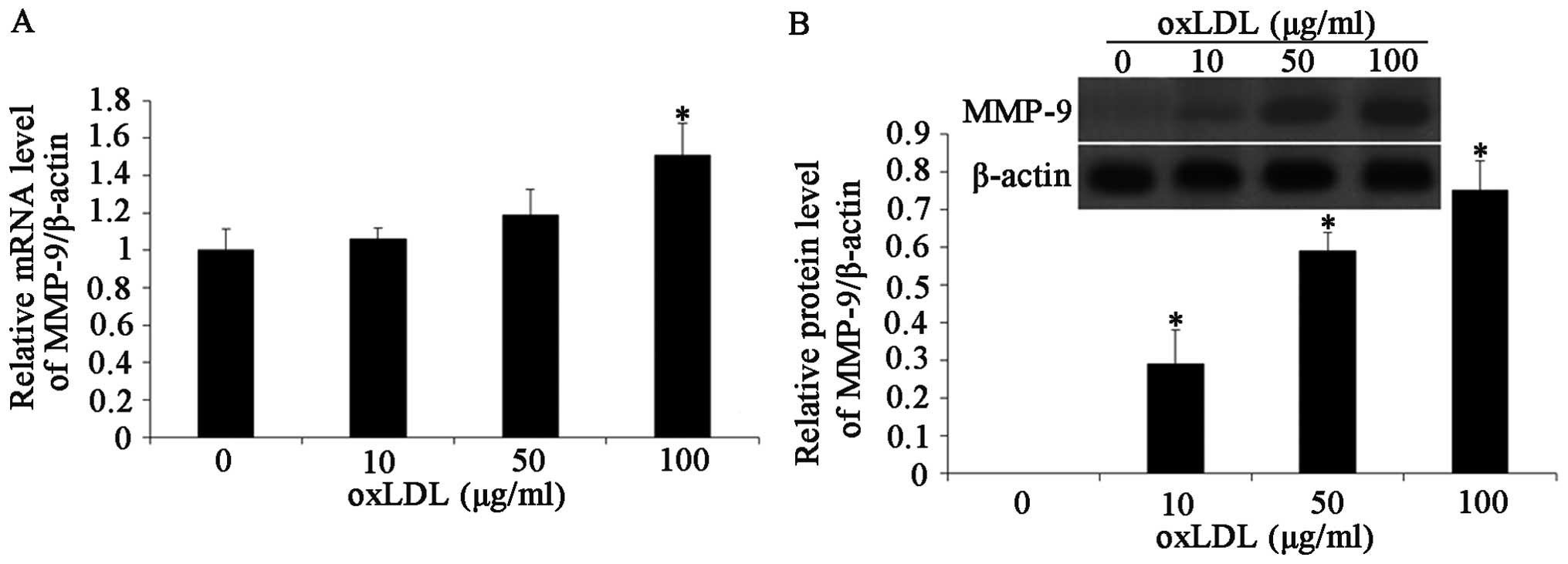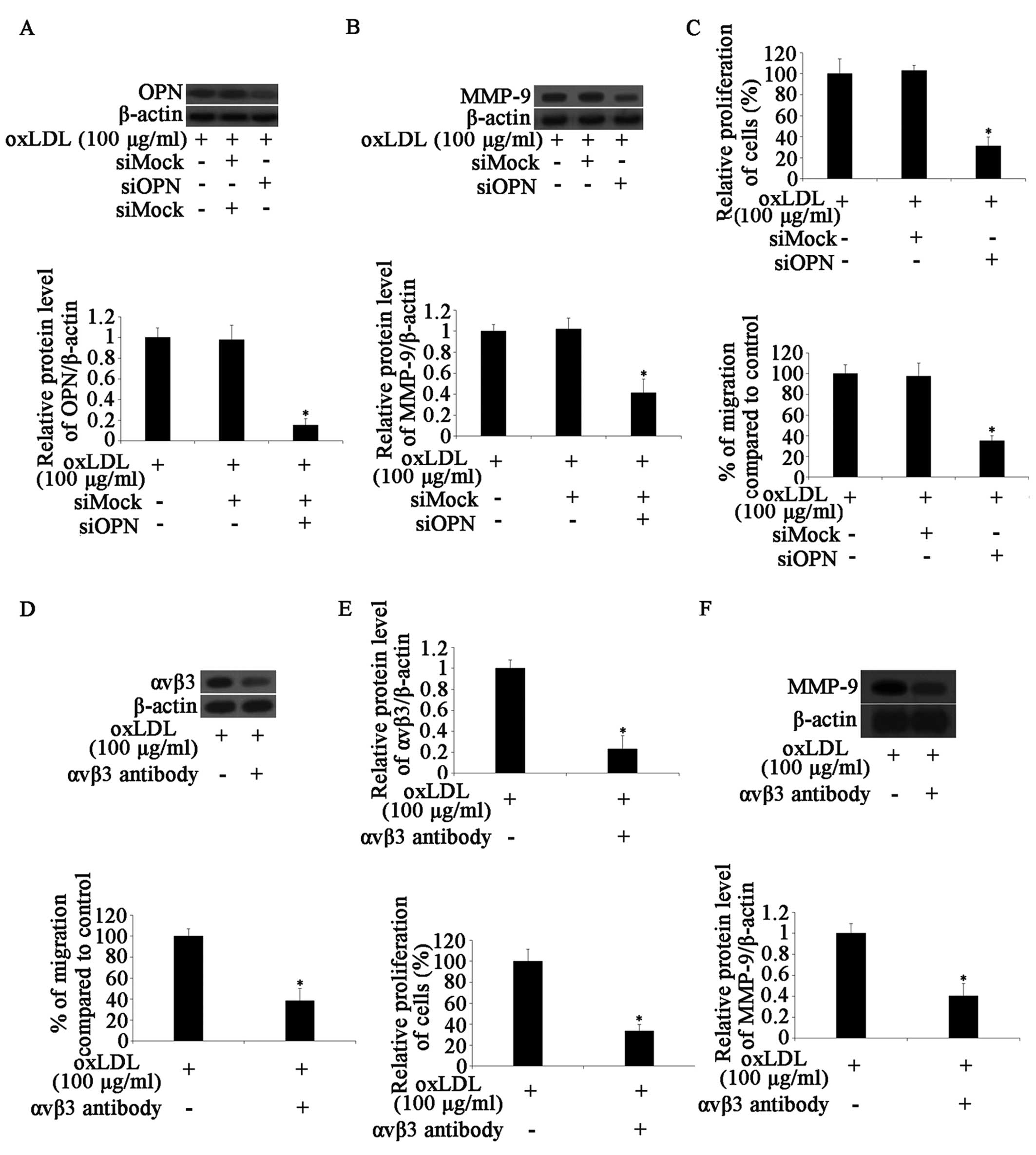|
1
|
Wang XH, Wang F, You SJ, et al:
Dysregulation of cystathionine γ-lyase (CSE)/hydrogen sulfide
pathway contributes to ox-LDL-induced inflammation in macrophage.
Cell Signal. 25:2255–2262. 2013.
|
|
2
|
Glass CK and Witztum JL: Atherosclerosis:
the road ahead. Cell. 104:503–516. 2001. View Article : Google Scholar : PubMed/NCBI
|
|
3
|
González-Navarro H, Abu Nabah YN, Vinué Á,
et al: p19(ARF) deficiency reduces macrophage and vascular smooth
muscle cell apoptosis and aggravates atherosclerosis. J AM Coll
Cardiol. 55:2258–2268. 2010.PubMed/NCBI
|
|
4
|
Gerthoffer WT: Mechanisms of vascular
smooth muscle cell migration. Circ Res. 100:607–621. 2007.
View Article : Google Scholar : PubMed/NCBI
|
|
5
|
Murry CE, Gipaya CT, Bartosek T, Benditt
EP and Schwartz SM: Monoclonality of smooth muscle cells in human
atherosclerosis. Am J Pathol. 151:697–705. 1997.PubMed/NCBI
|
|
6
|
Johnson JL, Dwivedi A, Somerville M,
George SJ and Newby AC: Matrix metalloproteinase (MMP)-3 activates
MMP-9 mediated vascular smooth muscle cell migration and neointima
formation in mice. Arterioscl Thromb Vas. 31:e35–e44. 2011.
View Article : Google Scholar : PubMed/NCBI
|
|
7
|
Li LX, Zhang XF, Bai X and Tong Q: SDF-1
promotes ox-LDL induced vascular smooth muscle cell proliferation.
Cell Biol Int. 37:988–994. 2013. View Article : Google Scholar : PubMed/NCBI
|
|
8
|
Ross R: The pathogenesis of
atherosclerosis - an update. New Engl J Med. 314:488–500. 1986.
View Article : Google Scholar : PubMed/NCBI
|
|
9
|
Clarke MC, Figg N, Maguire JJ, et al:
Apoptosis of vascular smooth muscle cells induces features of
plaque vulnerability in atherosclerosis. Nat Med. 12:1075–1080.
2006. View
Article : Google Scholar : PubMed/NCBI
|
|
10
|
Bennett MR and Boyle JJ: Apoptosis of
vascular smooth muscle cells in atherosclerosis. Atherosclerosis.
138:3–9. 1998. View Article : Google Scholar : PubMed/NCBI
|
|
11
|
Mazière C, Gomila C and Mazière JC:
Oxidized low-density lipoprotein increases osteopontin expression
by generation of oxidative stress. Free Radical Bio Med.
48:1382–1387. 2010.PubMed/NCBI
|
|
12
|
Cho HJ, Cho HJ and Kim HS: Osteopontin: a
multifunctional protein at the crossroads of inflammation,
atherosclerosis, and vascular calcification. Curr Atheroscler Rep.
11:206–213. 2009. View Article : Google Scholar : PubMed/NCBI
|
|
13
|
Giachelli CM, Lombardi D, Johnson RJ,
Murry CE and Almeida M: Evidence for a role of osteopontin in
macrophage infiltration in response to pathological stimuli in
vivo. Am J Pathol. 152:353–358. 1998.PubMed/NCBI
|
|
14
|
Weber GF, Zawaideh S, Hikita S, Kumar VA,
Cantor H and Ashkar S: Phosphorylation-dependent interaction of
osteopontin with its receptors regulates macrophage migration and
activation. J Leukocyte Biol. 72:752–761. 2002.PubMed/NCBI
|
|
15
|
Koh A, Da Silva AP, Bansal AK, et al: Role
of osteopontin in neutrophil function. Immunology. 122:466–475.
2007. View Article : Google Scholar : PubMed/NCBI
|
|
16
|
Ikeda T, Shirasawa T, Esaki Y, Yoshiki S
and Hirokawa K: Osteopontin mRNA is expressed by smooth
muscle-derived foam cells in human atherosclerotic lesions of the
aorta. J Clin Invest. 92:2814–2820. 1993. View Article : Google Scholar : PubMed/NCBI
|
|
17
|
Zohar R, Suzuki N, Suzuki K, et al:
Intracellular osteopontin is an integral component of the CD44-ERM
complex involved in cell migration. J Cell Physiol. 184:118–130.
2000. View Article : Google Scholar : PubMed/NCBI
|
|
18
|
Shannon KE, Keene JL, Settle SL, et al:
Anti-metastatic properties of RGD-peptidomimetic agents S137 and
S247. Clin Exp Metastasis. 21:129–138. 2004. View Article : Google Scholar : PubMed/NCBI
|
|
19
|
Chen YJ, Wei YY, Chen HT, et al:
Osteopontin increases migration and MMP-9 up-regulation via αvβ3
integrin, FAK, ERK, and NF-κB-dependent pathway in human
chondrosarcoma cells. J Cell Physiol. 221:98–108. 2009.PubMed/NCBI
|
|
20
|
Newby AC: Matrix metalloproteinases
regulate migration, proliferation, and death of vascular smooth
muscle cells by degrading matrix and non-matrix substrates.
Cardiovasc Res. 69:614–624. 2006. View Article : Google Scholar
|
|
21
|
Johnson C and Galis ZS: Matrix
metalloproteinase-2 and -9 differentially regulate smooth muscle
cell migration and cell-mediated collagen organization. Arterioscl
Thromb Vasc Biol. 24:54–60. 2004. View Article : Google Scholar : PubMed/NCBI
|
|
22
|
Kuzuya M, Kanda S, Sasaki T, et al:
Deficiency of gelatinase a suppresses smooth muscle cell invasion
and development of experimental intimal hyperplasia. Circulation.
108:1375–1381. 2003. View Article : Google Scholar : PubMed/NCBI
|
|
23
|
Johnson JL, George SJ, Newby AC and
Jackson CL: Divergent effects of matrix metalloproteinases 3, 7, 9,
and 12 on atherosclerotic plaque stability in mouse brachiocephalic
arteries. Proc Natl Acad Sci USA. 102:15575–15580. 2005. View Article : Google Scholar : PubMed/NCBI
|
|
24
|
Belcher J, Egan JO, Bridgman G, Baker R
and Flack JM: A micro-enzymatic method to measure cholesterol and
triglyceride in lipoprotein subfractions separated by density
gradient ultracentrifugation from 200 microliters of plasma or
serum. J Lipid Res. 32:359–370. 1991.
|
|
25
|
Feng X, Zhang Y, Xu R, et al:
Lipopolysaccharide up-regulates the expression of Fcalpha/mu
receptor and promotes the binding of oxidized low-density
lipoprotein and its IgM antibody complex to activated human
macrophages. Atherosclerosis. 208:396–405. 2010. View Article : Google Scholar : PubMed/NCBI
|
|
26
|
Lowry OH, Rosebrough NJ, Farr AL and
Randall RJ: Protein measurement with the Folin phenol reagent. J
biol Chem. 193:265–275. 1951.PubMed/NCBI
|
|
27
|
Shyu KG, Chen SC, Wang BW, Cheng WP and
Hung HF: Mechanism of the inhibitory effect of atorvastatin on
leptin expression induced by angiotensin II in cultured human
coronary artery smooth muscle cells. Clin Sci (Lond). 122:33–42.
2012. View Article : Google Scholar
|
|
28
|
Pellet-Many C, Frankel P, Evans IM, Herzog
B, Jünemann-Ramirez M and Zachary IC: Neuropilin-1 mediates PDGF
stimulation of vascular smooth muscle cell migration and signalling
via p130Cas. Biochem J. 435:609–618. 2011. View Article : Google Scholar : PubMed/NCBI
|
|
29
|
Livak KJ and Schmittgen TD: Analysis of
relative gene expression data using real-time quantitative PCR and
the 2(−Delta Delta C(T)) Method. Methods. 25:402–408. 2001.
|
|
30
|
Aikawa M, Rabkin E, Okada Y, et al: Lipid
lowering by diet reduces matrix metalloproteinase activity and
increases collagen content of rabbit atheroma: a potential
mechanism of lesion stabilization. Circulation. 97:2433–2444. 1998.
View Article : Google Scholar
|
|
31
|
Rangaswami H and Kundu GC: Osteopontin
stimulates melanoma growth and lung metastasis through
NIK/MEKK1-dependent MMP-9 activation pathways. Oncol Rep.
18:909–915. 2007.PubMed/NCBI
|
|
32
|
Wai PY and Kuo PC: Osteopontin: regulation
in tumor metastasis. Cancer Metastasis Rev. 27:103–118. 2008.
View Article : Google Scholar : PubMed/NCBI
|
|
33
|
Doran AC, Meller N and McNamara CA: Role
of smooth muscle cells in the initiation and early progression of
atherosclerosis. Arterioscler Thromb Vasc Biol. 28:812–819. 2008.
View Article : Google Scholar : PubMed/NCBI
|
|
34
|
Lusis AJ: Atherosclerosis. Nature.
407:233–241. 2000. View
Article : Google Scholar : PubMed/NCBI
|
|
35
|
Augé N, Maupas-Schwalm F, Elbaz M, et al:
Role for matrix metalloproteinase-2 in oxidized low-density
lipoprotein-induced activation of the sphingomyelin/ceramide
pathway and smooth muscle cell proliferation. Circulation.
110:571–578. 2004.
|
|
36
|
Ricciarelli R, Zingg JM and Azzi A:
Vitamin E reduces the uptake of oxidized LDL by inhibiting CD36
scavenger receptor expression in cultured aortic smooth muscle
cells. Circulation. 102:82–87. 2000. View Article : Google Scholar : PubMed/NCBI
|
|
37
|
Auge N, Garcia V, Maupas-Schwalm F, Levade
T, Salvayre R and Negre-Salvayre A: Oxidized LDL-induced smooth
muscle cell proliferation involves the EGF receptor/PI-3 kinase/Akt
and the sphingolipid signaling pathways. Arterioscl Thromb Vasc
Biol. 22:1990–1995. 2002. View Article : Google Scholar : PubMed/NCBI
|
|
38
|
Witztum JL and Steinberg D: The oxidative
modification hypothesis of atherosclerosis: does it hold for
humans? Trends Cardiovas Med. 11:93–102. 2001. View Article : Google Scholar : PubMed/NCBI
|














